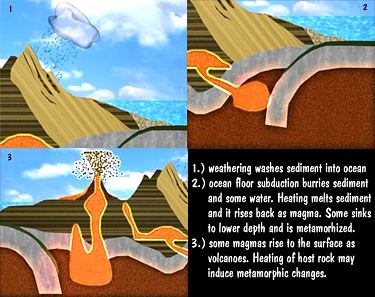
The main result of the hydrology cycle is erosion and the production of small particles from larger forms. Rain produces rivers which cut into the landscape and create small particles that act like sand paper creating more small particles that are transported from higher to lower elevation.
This material (sediment) forms one of the basic building materials for new types of rock. It is transported to larger bodies of water where it is deposited into layers.
The layers are often graded by the transportation process into orderly size distributions. This happens because larger particles tend to move slower through the system and fall out first.
The sediments can then be buried under more sediments and begin a process that forms sedimentary rocks. Sedimentary rocks are fundamentally "glued conglomerates".
Sedimentary material may also be subducted to lower regions at the plate boundaries and aid in the formation of magma. Or it may be included by a magma, and from the heating and pressure of the uprising magma it can be transformed into metamorphic rock.
Geothermal warming plus the heat creating at plate boundaries can make both mantle rock and subducted material melt and form magmas (rock solutions) which can then rise into the surrounding layers. Hot rock (especially with entrapped gases (water and carbon dioxide) is lighter and will tend to automatically rise. There maybe insufficient heat or energy to make it break through the earth's crust, and lacking sufficient energy it cools before reaching the surface forming underground igneous rock masses.
If the energy is sufficient, then it may break the crust forming a volcano and extrude or explode igneous material into the atmosphere where it literally creates new crust. As the hot igneous rock contacts the rocks around it, the tremendous heat may change the associated rock into other forms "metamorphosing" it into other rock material.
Metamorphic transformations can occur when a material is buried to sufficient depth to encounter high pressure and or temperature to change its structure and composition.
| NEXT | TOC | PREV |